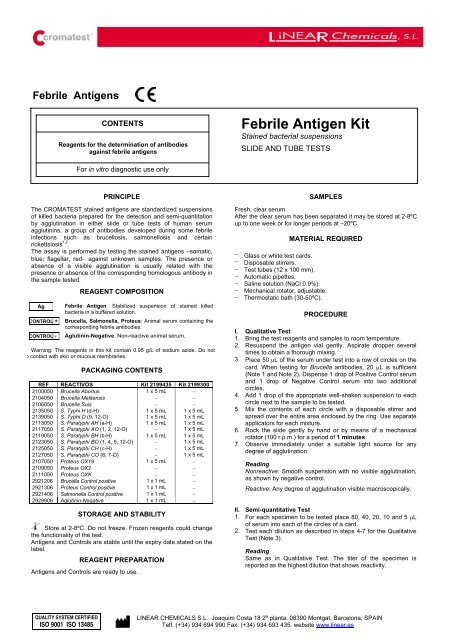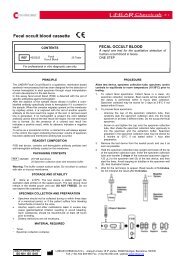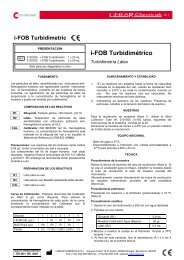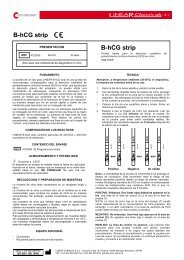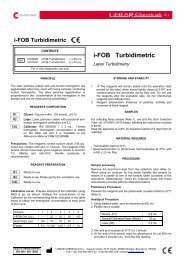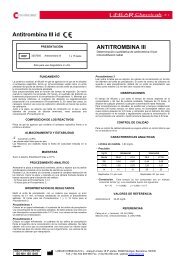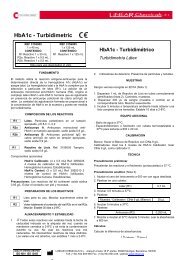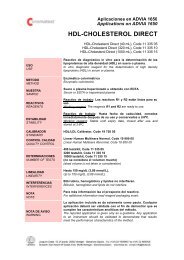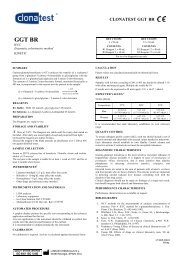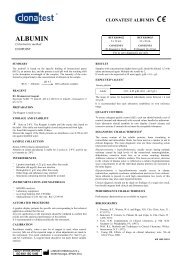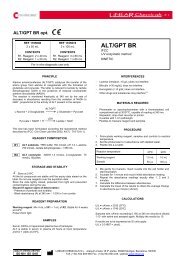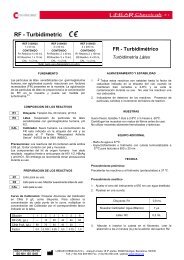Febrile Antigen Kit - Linear
Febrile Antigen Kit - Linear
Febrile Antigen Kit - Linear
Create successful ePaper yourself
Turn your PDF publications into a flip-book with our unique Google optimized e-Paper software.
<strong>Febrile</strong> <strong>Antigen</strong>sCONTENTSReagents for the determination of antibodiesagainst febrile antigens<strong>Febrile</strong> <strong>Antigen</strong> <strong>Kit</strong>Stained bacterial suspensionsSLIDE AND TUBE TESTSFor in vitro diagnostic use onlyPRINCIPLEThe CROMATEST stained antigens are standardized suspensionsof killed bacteria prepared for the detection and semi-quantitationby agglutination in either slide or tube tests of human serumagglutinins, a group of antibodies developed during some febrileinfections such as brucellosis, salmonellosis and certainrickettsiosis 1,2 .The assay is performed by testing the stained antigens –somatic,blue; flagellar, red− against unknown samples. The presence orabsence of a visible agglutination is usually related with thepresence or absence of the corresponding homologous antibody inthe sample tested.AgCONTROL +CONTROL -REAGENT COMPOSITION<strong>Febrile</strong> <strong>Antigen</strong>. Stabilized suspension of stained killedbacteria in a buffered solution.Brucella, Salmonella, Proteus: Animal serum containing thecorresponding febrile antibodies.Aglutinin-Negative. Non-reactive animal serum.Warning: The reagents in this kit contain 0.95 g/L of sodium azide. Do noto contact with skin or mucous membranes.PACKAGING CONTENTSREF REACTIVOS <strong>Kit</strong> 2199435 <strong>Kit</strong> 21993002100050 Brucella Abortus 1 x 5 mL −2104050 Brucella Melitensis − −2106050 Brucella Suis − −2135050 S. Typhi H (d-H) 1 x 5 mL 1 x 5 mL2139050 S. Typhi O (9, 12-O) 1 x 5 mL 1 x 5 mL2113050 S. Paratyphi AH (a-H) 1 x 5 mL 1 x 5 mL2117050 S. Paratyphi AO (1, 2, 12-O) − 1 x 5 mL2119050 S. Paratyphi BH (b-H) 1 x 5 mL 1 x 5 mL2123050 S. Paratyphi BO (1, 4, 5, 12-O) − 1 x 5 mL2125050 S. Paratyphi CH (c-H) − 1 x 5 mL2127050 S. Paratyphi CO (6, 7-O) − 1 x 5 mL2107050 Proteus OX19 1 x 5 mL −2109050 Proteus OX2 − −2111050 Proteus OXK − −2921206 Brucella Control positive 1 x 1 mL −2921306 Proteus Control positive 1 x 1 mL −2921406 Salmonella Control positive 1 x 1 mL −2929906 Aglutinin-Negative 1 x 1 mL −STORAGE AND STABILITYStore at 2-8ºC. Do not freeze. Frozen reagents could changethe functionality of the test.<strong>Antigen</strong>s and Controls are stable until the expiry date stated on thelabel.REAGENT PREPARATION<strong>Antigen</strong>s and Controls are ready to use.SAMPLESFresh, clear serum.After the clear serum has been separated it may be stored at 2-8ºCup to one week or for longer periods at –20ºC._______I.1.2.3.4.5.6.7.II.1.2.MATERIAL REQUIREDGlass or white test cards.Disposable stirrers.Test tubes (12 x 100 mm).Automatic pipettes.Saline solution (NaCl 0.9%).Mechanical rotator, adjustable.Thermostatic bath (30-50ºC).PROCEDUREQualitative TestBring the test reagents and samples to room temperature.Resuspend the antigen vial gently. Aspirate dropper severaltimes to obtain a thorough mixing.Place 50 μL of the serum under test into a row of circles on thecard. When testing for Brucella antibodies, 20 μL is sufficient(Note 1 and Note 2). Dispense 1 drop of Positive Control serumand 1 drop of Negative Control serum into two additionalcircles.Add 1 drop of the appropriate well-shaken suspension to eachcircle next to the sample to be tested.Mix the contents of each circle with a disposable stirrer andspread over the entire area enclosed by the ring. Use separateapplicators for each mixture.Rock the slide gently by hand or by means of a mechanicalrotator (100 r.p.m.) for a period of 1 minutes.Observe immediately under a suitable light source for anydegree of agglutination.ReadingNonreactive: Smooth suspension with no visible agglutination,as shown by negative control.Reactive: Any degree of agglutination visible macroscopically.Semi-quantitative TestFor each specimen to be tested place 80, 40, 20, 10 and 5 μLof serum into each of the circles of a card.Test each dilution as described in steps 4-7 for the QualitativeTest (Note 3).ReadingSame as in Qualitative Test. The titer of the specimen isreported as the highest dilution that shows reactivity.QUALITY SYSTEM CERTIFIEDISO 9001 ISO 13485LINEAR CHEMICALS S.L. Joaquim Costa 18 2ª planta. 08390 Montgat, Barcelona, SPAINTelf. (+34) 934 694 990 Fax. (+34) 934 693 435. website www.linear.es
III.1.Tube Agglutination TestUsing saline solution as a diluent, prepare for each antigen tobe tested a row of doubling dilutions of the specimen asfollows:Tube 1 2 3 4 5 6Control Control ControlSusp. + −Saline Sol.0.95% 1.9 1.0 1.0 1.0 1.0 1.0 1.0 1.0 1.0(mL)+ + + + + + + +Serum(µL)100 1 mL serial dilutions − 2 drops 2 dropsMix1.02.3.4.Add 1 drop of the appropriate well-shaken suspension to eachtube of a given row. Mix. Final serum dilutions will be: 1:20,1:40, 1:80, 1:160, 1:320, 1:640.Incubate at 37ºC for 24 hours. (Note 4).Examine macroscopically for agglutination.ReadingRead the results of all control tubes first. After the examiningthe pattern of the sediment shake the tube gently.Nonreactive: In a negative reaction and in the SuspensionControl tube there is no clumping visible. Suspension shows atypical swirl when the tube is flicked.Reactive: Partial or complete agglutination with variable degreeof clearing of the supernatant fluid.The titer is reported as the highest dilution that showsagglutination. The next higher dilution should be negative.QUALITY CONTROLPositive and negative serums as well as Suspension Control tubesshould be run daily to check the operativity of the system.EXPECTED VALUESSalmonella and Brucella: Titers greater than 1/80 (somatic andbrucella antigens) and 1/160 (flagellar antigens) indicates recentinfection.Proteus: Titer of less than 1/160 should not be consideredsignificant.A single positive result has less clinical significance than thedemonstration of a rising or decreasing titre between successiveserum specimens taken days apart.CLINICAL SIGNIFICANCE<strong>Febrile</strong> <strong>Antigen</strong> is a term which has been accepted generally asreferring to bacterial suspensions representative of a number ofpathogenic microorganisms to human, involved in some bacterialinfections (brucellosis, salmonellosis and certain rickettsiosis) whichare accompanied by a fever in the host. The best option to establishthe etiology of an infectious disease is by isolation and identificationof the causative agent. However, these culture techniques may bedifficult to use and the febrile serodiagnostic tests becomeimportant to detect the antibodies produced in the patient serumduring the infection (indirect method of diagnosis).Testing <strong>Febrile</strong> <strong>Antigen</strong>s has a high diagnostic value as theirexclusion or detection can support or place doubt on a tentativediagnosis made on the basis of case history data and clinicalfindings._______ANALYTICAL PERFORMANCEThere is not a Reference Material for the sensitivitystandardization of these reagents. For this reason, <strong>Linear</strong>Chemicals adjust the sensitivity of their reagents against tospecific antisera and commercial reagents of certified quality.Prozone effect: False negative results may be obtained with seracontaining a high titer of antibodies. A dilution of these sera willgive a positive result.Results obtained with this reagent did not show significativedifferences when compared with reference reagents. Details ofthe comparison experiments are available on request.Hemoglobin (


